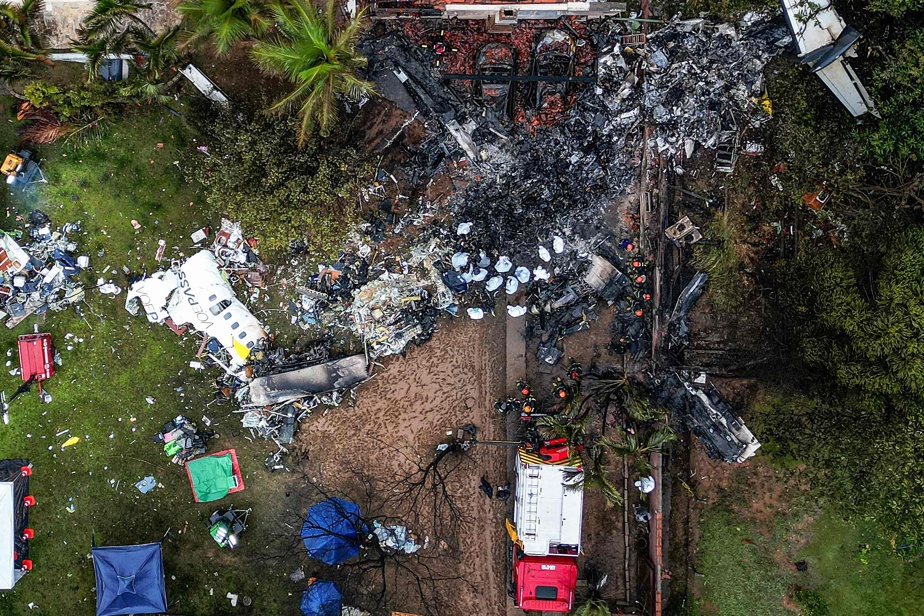(Vinhedo) Brazilian authorities on Saturday recovered the bodies of the 62 victims of the spectacular plane crash near Sao Paulo, in the southeast of the country, while beginning to examine the black boxes to determine the causes of the tragedy.
The plane crashed on Friday in Vinhedo, a city located some 80 kilometers northwest of Sao Paulo, Brazil’s economic capital.
After an impressive nosedive, shown in videos shared on social media by locals, the plane crashed in the garden of a house in a residential complex.
“A total of 62 bodies (34 male and 28 female) were recovered and taken to the morgue in Sao Paulo for identification and delivery to their families,” the regional government said.
Two bodies have already been identified, the pilot and the co-pilot, according to the mayor of Vinhedo, Dario Pacheco.
The Brazilian Center for Investigation and Prevention of Aeronautical Accidents (Cenipa) has opened an investigation and has begun analyzing the two black boxes.
It plans to publish “within an estimated 30 days a preliminary report on the accident,” the Brazilian Air Force (FAB) announced.

PHOTO NELSON ALMEIDA, AGENCE FRANCE-PRESSE
Security personnel guard the entrance to the Recanto Florido Condominium, where a plane crashed, on August 9 in Vinhedo.
Three days of national mourning
Dozens of firefighters, rescue workers and police officers worked on the ground Saturday to recover the bodies.
Although no residents of the Recanto Florido residence were injured, the shock was enormous.
“It was a feeling of panic, of helplessness. […]”It’s something really very sad,” Roberta Henrique, 38, president of the neighbors’ association, told AFP.
The residents are “scared, psychologically affected,” she added, very moved.
Brazilian President Luiz Inacio Lula da Silva has declared three days of national mourning.
The plane, from the Franco-Italian manufacturer ATR, was carrying 58 passengers and four crew members, according to the airline Voepass.
The victims had identity documents issued in Brazil, according to Voepass. There was also a woman with dual Brazilian and Portuguese nationality, as well as a family of three Venezuelans.
Sudden loss of altitude

PHOTO ANDRE PENNER, ASSOCIATED PRESS
View of the debris at the site where the plane crashed
The plane was flying from Cascavel, in the southern state of Parana, to Guarulhos International Airport in Sao Paulo. It crashed at 1:25 p.m. (12:25 p.m. Eastern Time).
According to flight tracking website Flight Radar 24, the plane flew for about an hour at 17,000 feet (5,180 meters). At 1:21 p.m. it began to lose altitude and within a minute it dropped sharply to 4,100 feet (1,250 meters).
According to the FAB, “the loss of contact with the radar occurred at 13:22” and before that the aircraft had not reported an “emergency situation” or “adverse weather conditions”.
Cenipa experts are analyzing in Brasilia the two black boxes recovered from the plane, containing cabin conversations and flight data, explained General Marcelo Moreno, head of Cenipa.
This “important information will be able to tell us what happened during this tragic event,” he stressed.
According to the National Civil Aviation Agency, the aircraft, which had been flying since 2010, complied with all current standards.
Frost Hypothesis
It had undergone “routine maintenance the night before” and left Ribeirao Preto, a city in the state of Sao Paulo where Voepass is headquartered, “without any technical problems,” said the company’s operations director, Marcel Moura.
Experts have speculated that frost forming on the plane’s wings may have caused the crash.
Mr Moura acknowledged that this model of aircraft flies “at a type of altitude where there is a greater sensitivity to frost”. The weather forecast for Friday predicted frost but at levels “acceptable for a flight”, he explained.
Founded in 1995 as Passaredo, Voepass has a fleet of 15 aircraft and is the fourth largest airline in the Brazilian domestic market, according to the company.
The plane that crashed was an ATR 72-500. The manufacturer ATR, a subsidiary of Airbus and the Italian Leonardo, said its specialists are “engaged to support the investigation.”
This is the first major air disaster in Brazil in 17 years.
In 2009, an Air France Airbus A330-230, flying between Rio de Janeiro and Paris, crashed into the Atlantic in a zone of turbulence with 228 people on board.
